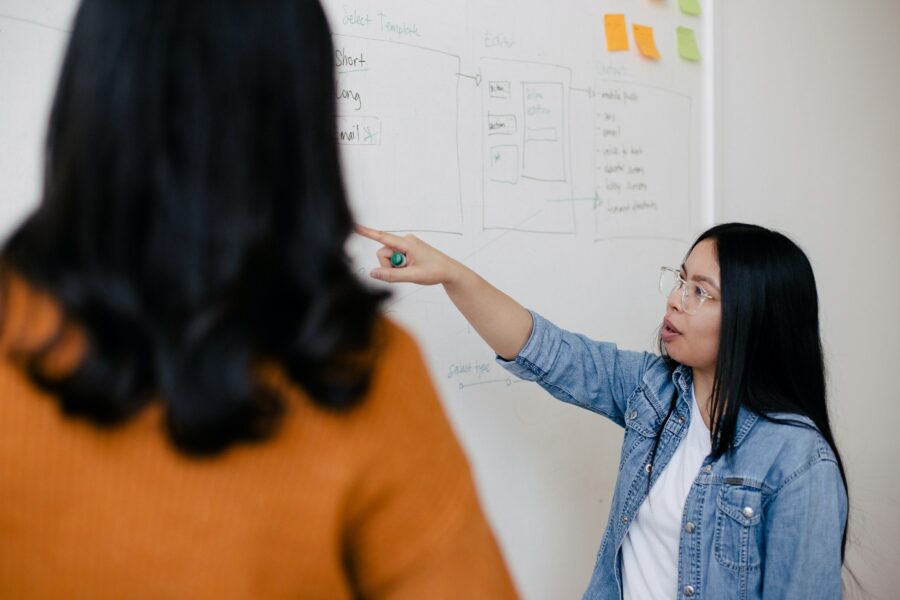When thinking about what route you want to take to learn or teach something new, you’re going to quickly realize just how many options are out there. Especially when you’re looking at options online, in-person, available via mobile applications, through reading textbooks, or any variety of learning that’s available – it feels overwhelming.
One way to help narrow down your search is to look at informal versus formal education. Understanding this distinction in learning approaches provides an overarching way to break down how you want to learn. From there, you’ll be able to look for specific options that can give you the lessons you need – or you could create your own hybrid training program that has the best of both approaches!
Skip ahead:
- What is formal education?
- What is informal education?
- Similarities between formal and informal education
- Differences between formal and informal education
- How formal and informal education complement each other
What is formal education?
Formal education is training that has a specific curriculum. It’s clear what will be taught, in what way the content will be delivered, and how the student’s learning will be measured (eg. tests, presentations, research articles, etc).
Most formal education is done through an institution such as a school, university, or even a tutor. However, there are also a lot of e-learning marketplaces like Udemy or Khan Academy which offer many types of courses with specific learning objectives. Regardless of where you go to earn your formal education, it can be delivered to you through one lesson or course, or can even extend out to an entire undergraduate or graduate degree, for example.
There are also a lot of supplemental resources available in formal education such as textbooks, keynote presentations, hands-on labs, and practice exams.
What is informal education?
Informal education is, in some ways, the opposite of formal education. Most often, informal education isn’t even planned in advance. A lot of lessons are pulled from everyday life, such as when you hear a story from a family member or co-worker that you later apply to your own life. As such, there’s not really any use of reading materials, guides, or exams as there would be in formal learning paths.
Because of its unstructured and sometimes unpredictable nature, you may not always guarantee exactly what you’re going to learn. It can sometimes be faster to take in new information in informal settings, but in other cases it can be longer. The speed of your learning is more heavily dependent on who is teaching you (as they’re not actually a professional educator) and your readiness and willingness to learn in the moment.
Similarities between formal and informal education
Despite seeming so different, there’s actually a few things that both informal and formal education approaches have in common. These are essential takeaways from any kind of learning activity, and they’re especially important to keep in mind here, too.
Drive to learn
As silly as it sounds, one of the biggest similarities between formal and informal education is that the student has a drive to learn! You might either be looking to have new knowledge or even just try to expand on knowledge that you’ve earned from a prior learning experience. Either way, this person must be ready to be curious, to understand new concepts, and to ask questions when they’re confused.
Lessons learned
Regardless of how you learn, you’re still going to learn. Lessons can be taught in a lot of different ways, and some people need more structure to digest the information while others need a hands-on, in-practice approach. No matter how you go about learning, you’re still going to have similar takeaways at the end of the day. This is especially true if you’ve specifically set out to learn something in particular, and you’ve asked people who you know are going to be experts in the field. In this case, getting a lesson from a university class might give you the same information as your next door neighbor who’s had a career in that area their whole life.
Differences between formal and informal education
Formal and informal education settings have a lot of differences, which can help you with making the right decision for what you’re looking to learn next. Let’s dive into a few of these differences here!
Learning environment
Put simply, formal education is mostly done within a classroom setting and informal education is done during your day-to-day life activities. Today, a lot of classes for formal lessons are hosted online as well as in-person, so there’s a lot of flexibility in how you can access this type of education.
On the other hand, there’s no go-to place to get all of your informal learning needs. Instead, it might take some practice asking around, doing solo research, or observing your environment to get the same kind of lessons. In that way, informal education is great for people who like to “learn by doing.”
Learning structure
Courses offered in formal learning paths allow students to know exactly what they’re going to learn. Professors strategically plan course topics to build off each other, often so that more basic concepts are learned first before diving into advanced topics. There’s more predictability for knowing how the course will work with your learning style as well.
However, informal learning doesn’t guarantee what you’re going to learn, or how. You might even stumble upon a new lesson unintentionally! And even if you’re actively seeking a specific answer, you might get part of the information from one source and the rest of the information from somewhere else. Because of this, you might frequently learn the more advanced topics first before the fundamentals – and it won’t make sense right away until you’ve had that other piece of the lesson come into your learning path. As complicated as this sounds, it can be good for people who like diving head-first into things.
Predictability for course length
With formal education paths, you can choose to take longer or shorter courses, and the course length will always be clearly stated before you even start the course. This is great for knowing how in-depth you want to go when learning about a given topic.
Informal education, on the other hand, isn’t predictable for time. You might learn something in five minutes or you might find you’re spending a lot of your personal time researching around to find the answer. Because you don’t have anyone who’s already done the research and is offering to teach you the content within a set period, the amount of time for you to find and understand the same information can vary greatly.
Types of skill development
Because of how different the learning approaches are in each type of education, the skills that are actually learned are different. For formal education, students tend to get more theoretical knowledge around a specialized area. But in informal education, students have the opportunity to practice hands-on work which can give practical experience and build strong interpersonal skills like communication, negotiation, team work, and active listening. This is great for activating knowledge that you’ve earned in a prior learning experience!
Cost
Often, informal training is a lot less expensive than formal training programs. The reason is because informal learning can also happen throughout your day-to-day life experiences such as what you learn from a friend’s story about handling a difficult situation at work. Informal education also relies on readily available information such as what library books, online search engines, and your network of connections have in store already!
On the other hand, formal education usually requires coordinating experts or professors to teach the content, a space to host the lesson, and sometimes even reading materials like textbooks.
How formal and informal education complement each other
There’s no rule that says you only need to rely on either formal or information education when learning something new. In fact, creating a hybrid mix of both approaches might even accelerate your learning! The best way to do this is by getting practical experience while partaking in a formal learning experience.
For example, if you’re taking a class about How to Use Social Media for Marketing, this is the formal element that provides a good foundation of theoretical knowledge on how to use social media. At the same time, you can play around in your social media tools to see how different settings work or how different content types perform. You can also ask any social media experts in your network about their opinions on what works best or what trends are currently top performing. This is your informal learning experience that will give you hands-on insights about what really works. Then, while you’re following along your course, you’ll know more about what the theory is explaining, and you’ll have some of your own practical knowledge to reflect on!
Conclusion
Formal and informal education are two very different approaches to learning. One method may be better suited for your preferences or type of content that you’re learning about. Both types can provide great benefits and ultimately, both will help you get the answer you need. The true value comes from combining both approaches to apply theoretical knowledge in real life situations! If you’re looking to dive into some formal learning, you can check out some of these great (and free!) courses!






